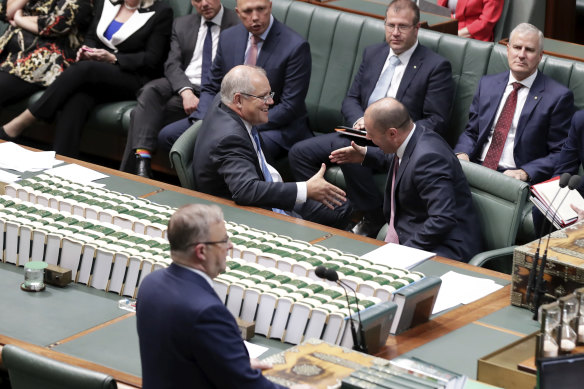This was published 3 years ago
Tax cuts to soon disappear as budget relies on workers to recover from COVID-19
By Shane Wright
Almost nine in 10 Australians will face higher average tax rates over the next decade despite the federal government’s three-stage income tax cut plan, with new independent analysis showing the budget will increasingly rely on ordinary workers to recover from the COVID-19 recession.
Work by the independent Parliamentary Budget Office, released on Tuesday, shows low and middle-income earners – particularly women – will suffer substantial increases in their average tax rates due to bracket creep.

Prime Minister Scott Morrison and Treasurer Josh Frydenberg shake hands after the government’s income tax bill passed the House of Representatives in 2019. But the changes will still mean millions of Australians facing bracket creep.Credit: Alex Ellinghausen
By the start of the next decade, with the budget still running a deficit of $52 billion, the share of government revenue coming from personal income tax will be at its highest rate since 1999.
The final stage of the government’s three-stage tax plan begins in mid-2024 with a large cut in tax rates for the nation’s highest income earners. That follows tax relief for low and middle-income earners that was rolled out from the 2018-19 budget.
The budget office, in a report into the long-term health of the budget, found the tax cuts reduce the average tax rate for all workers. The largest gains are for those earning between $120,000 and $160,000 with a reduction in their average tax rate of almost 6 percentage points.
But according to the PBO, these gains will be quickly swept away by bracket creep – where income growth results in a person paying an increasing proportion of their income in tax – by 2031-32.
It found just 13 per cent of all taxpayers, those earning between $96,000 and $160,000, would still have a lower average tax rate by early next decade. Workers across all other wage levels will suffer an increase in their average tax rate.
The biggest hit will be to those earning between $20,000 and $50,000, about 30 per cent of all workers, who will endure an increase of up to 6.6 percentage points in their average tax rates. People earning between $50,000 and $75,000 – another quarter of the population – face an increase of up to 3 percentage points.
Even those on the top 1 per cent income in the country, earning more than $309,000, will experience a small increase.
The impact of the increase, however, is not uniform with women facing twice the increase as men, largely due to more women working in part-time and lower-paying jobs.
The increase in average tax rates means the share of federal government revenue from workers will lift over the decade.
By 2031-32, 48.2 per cent of the government revenue will come from personal income tax. In 2018-19, it was 46.2 per cent.
As a share of GDP, personal income tax will reach 11.9 per cent, its highest level since 1999 just ahead of large tax cuts put in place to offset the impact of the GST.
Company tax’s share of total revenue will fall to 17.4 per cent from 19.4 per cent.
Despite revenue increasing over this whole period, the budget will remain mired in deficit. Government debt is expected to gradually edge down to about 27.8 per cent of GDP in 2060-61, about the same level it was before the coronavirus pandemic.
Government spending is expected to edge down as a share of GDP over the next decade but still remain higher than anything since the mid-1980s.
The PBO said the biggest increase over coming years would be the National Disability Insurance Scheme, which by the start of the next decade will be fourth-largest budget expense behind GST grants, the age pension and defence.
The scheme, forecast to cost $26.7 billion this year, is tipped to reach $59.3 billion by 2031-32.
The office said one of the reasons for the huge increase in expense for the NDIS was its structure.
“The number of potentially eligible NDIS participants depends on the nature and prevalence of eligible conditions – that is, permanent and significant disability or a developmental delay – and the budget each participant receives depends on their individual circumstances, which varies widely across participants,” it said.
The budget office warned the cost of aged care, forecast to grow to $49.8 billion from $25.2 billion, could be more given the recommendations of the recent royal commission into the sector.
There is no costing for the federal government’s recent decision to break its $90 billion submarine deal with France’s Naval Group.
The Morning Edition newsletter is our guide to the day’s most important and interesting stories, analysis and insights. Sign up here.